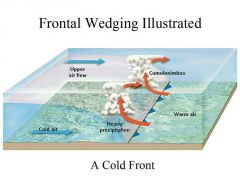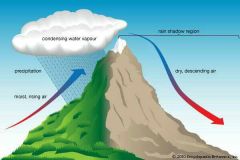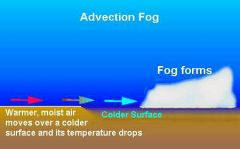![]()
![]()
![]()
Use LEFT and RIGHT arrow keys to navigate between flashcards;
Use UP and DOWN arrow keys to flip the card;
H to show hint;
A reads text to speech;
74 Cards in this Set
- Front
- Back
|
What is humidity |
Measure of how much water is in the air |
|
|
High humid = Low humidity = |
High water vapor Low water vapor |
|
|
Water vapor contributes up to what in the atmosphere |
4% |
|
|
Describe relative humidity |
Warm air can hold more water Cold air holds less water Amount of water vapor that is held at a given time How near the air is to saturation |
|
|
What is dew point |
When air is 100% saturated |
|
|
Describe adiabatic temperature change |
When air is compressed it warms When air is allowed to expand is cools |
|
|
Cold air holds..... |
Less water |
|
|
Condensation forms what 3 things and require what? |
Dew Fog Clouds Air reaches saturation |
|
|
Saturation occurs how? |
When sufficient water vapor is added to the air When air is cooled to its dew point |
|
|
A drop in temperature occurs even though heat is neither added nor subtracted |
Adiabatic temperature changes |
|
|
When air is allowed to expand it When air it is compressed it This is what |
Cools Warms Adiabatic temperature change |
|
|
When air rises it, making rh go When air defends it, making rh go |
Cools, up Warms, down |
|
|
Unsaturated air cools at |
10°c for every 1000 meters |
|
|
Unsaturated air that either is cooled or warmed during ascent or decent, at a rate of 10°c per 1000 meters is known as what |
Dry adiabatic rate |
|
|
If a parcel of air rises high enough it will eventually do what |
Cool to its dew point (saturation) where the process of condensation begins |
|
|
The released latent heat stored in water vapor releases causing condensation, which works against what, doing what |
Adiabatic process Reducing the rate at which air cools |
|
|
The slower rate of cooling caused by the addition of latent heat is called what |
Wet adiabatic rate |
|
|
Wet adiabatic rate |
6°c per 1000 meters |
|
|
Where clouds begin to form |
Dew point |
|
|
Dividing line between wet/dry adiabatic rate |
Dew point |
|
|
Processes that lift air |
Orographic lifting Frontal wedging Convergence Localized convective lifting |
|
|
Lifting of air by changes in surface elevation (mountainous barrier) |
Orographic lifting |
|
|
As air ascends a mountain what happens, this part of the mountain is called what and why |
Adiabatic cooling generates clouds and precipitation Windward, because it's wet from rainfall |
|
|
When air decends a mountain it does what, making what less likely. This side of the mountain is called what |
Warms Adiabatic ally Rain Leeward, dry |
|
|
Warmer, less dense airs forced over cooler, denser air, the cold air acts as what, forcing the warmer less dense air to what |
Frontal wedging Barrier Rise |
|
|
A pileup of horizontal airflow results in upward movement |
Convergence |
|
|
Air flows in from more than one direction, it does what and leads to what |
Goes up Adiabatic cooling and cloud formation Convergence |
|
|
When air moves from a smooth surface(ocean) onto a bumpy surface, the result is what |
Speed is reduced Pile up of air(convergence) Air rises |
|
|
Unequal surface heating causes localized pockets of air to rise because of their buoyancy |
Localized lifting |
|
|
Air above a paved parking lot will be warmed more than the air above an adjacent wooded park, causing what |
The parcel of air above the parking lot will be buoyed upward, called thermals, because the warmer air is less dense and rises Localized lifting |
|
|
In the am land does what In the pm land does what |
Warms faster Cools quicker |
|
|
Enviromental laps rate |
5.5°f per 1000 ft |
|
|
Types of clouds |
Cirrus Stratus Cumulus Cumulonimbus |
|
|
Clouds of high altitude, no precipitation formed, wispy |
Cirrus |
|
|
Clouds that cover the whole sky, |
Stratus |
|
|
Clouds shaped like cotton balls |
Cumulus |
|
|
Clouds that can have high and low altitude, produces severe weather; lightning, heavy rain, tornadoes |
Cumulonimbus |
|
|
Generates much of the precipitation that occurs in the middle latitudes |
Bergeron process |
|
|
Starts off as snow |
Bergeron process |
|
|
Vapor goes to liquid, once large enough it will fall, if above freezing, we get rain, if below freezing we get snow |
Bergeron process |
|
|
Process more common in the tropics, warm clouds |
Collision coalescence process |
|
|
Large cloud droplets do what, allowing them to do what |
Fall more rapidly than smaller droplets Sweep up the smaller droplets in their path and grow |
|
|
As rain droplets increase in size their what increases, resulting in what |
Fall velocity increases, resulting in increased air resistance causing the raindrop to flatten |
|
|
What happens when a raise drop exceeds 5 mm |
Breaks into smaller drops causing heavy rainfall |
|
|
What is the collision coalescence process |
Condensation of liquid |
|
|
3 common fogs |
Advection Radiation Steam |
|
|
How do we get fog |
When air at earth's surface is chilled below it's dew point |
|
|
What is advection fog |
When warn moist air moves over a cool surface |
|
|
Give an example of advection fog |
Warm moist air from the Pacific Ocean moves over the cold California current and is carried onshore by the prevailing winds |
|
|
What type of fog is common in Winter |
Advection |
|
|
Type of fog that occurs around sunset and can make driving hazerdous |
Radiation |
|
|
What is radiation fog |
Forms on cool clear nights, when earth's surface cools rapidly by radiation |
|
|
Cool air moves over warm water |
Steam fog |
|
|
Drops of water that fall from a cloud and have a diameter of atlas 0.5 mm |
Rain |
|
|
Raindrops rarely exceed |
5mm because of surface tension while falling down breaking it into smaller pieces |
|
|
Fine uniform drops of water having a diameter less than 0.5mm |
Drizzle |
|
|
Where do most rain drops originate |
Nimbostratus Cumulonimbus |
|
|
Drizzle originates from what type of clouds |
Stratus Nimbostratus |
|
|
Falls as ice |
Sleet |
|
|
Falls as ice but freezes on contact |
Freezing rain |
|
|
How is sleet produced |
A layer of air with above freezing temperature over lies a subfreezing layer near the ground |
|
|
How is freezing rain produced |
Similar to sleet formation, however the subfreezing air near the ground is not thick enough to allow the raindrops to freeze |
|
|
Balls of ice that are made of concentric layers |
Hail |
|
|
Only produced in large Cumulonimbus clouds |
Hail |
|

|
. |
|

|
Orographic lifting |
|

|
. |
|

|
. |
|
|
dry area on the lee side of a mountainous area (away from the wind). The mountains block the passage of rain-producing weather systems and cast a "shadow" of dryness behind them |
Rain shadow |
|
|
Major components of atoms |
Oxygen Nitrogen |
|
|
energy released or absorbed, by a body or a thermodynamic system, during a constant-temperature process. An example is a state of matter change, meaning a phase transition, such as ice melting or water boiling. |
Latent heat |
|
|
Helps heat earth |
Carbon dioxide Water vapor |
|
|
As their name suggests, greenhouse gases act much like the roof of a greenhouse they trap heat on Earth.This process happens in two steps. First, greenhouse gases let the visible and ultraviolet light in sunlight to pass through Earth's atmosphere unimpeded, and reach the Earth's surface. But then, when light strikes Earth's surface and is reflected back to the atmosphere as infrared energy, or heat, greenhouse gases absorb this heat and warm the planet. |
. |
|
|
What is environmental lapse rate |
The rate of decrease of atmospheric temperature with increase in altitude. |

